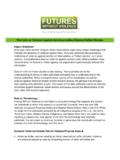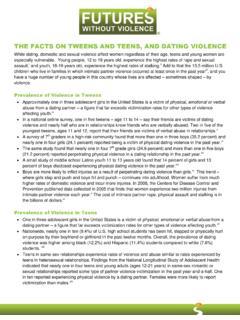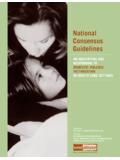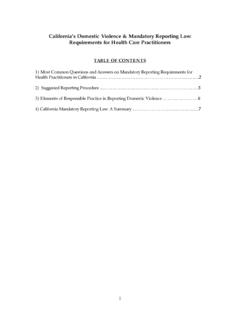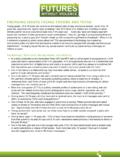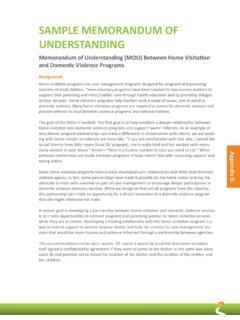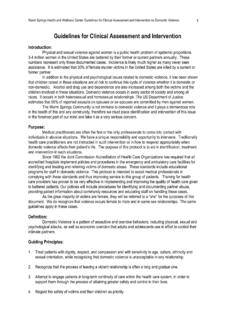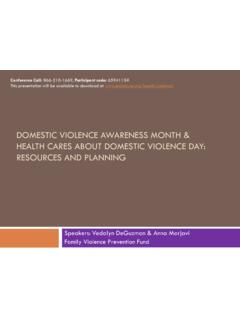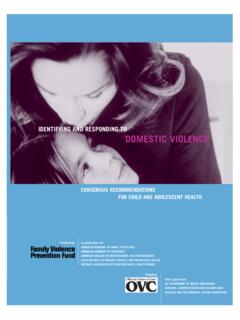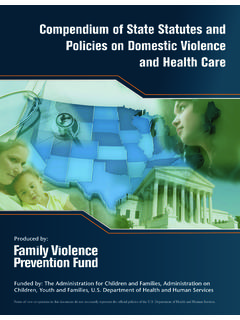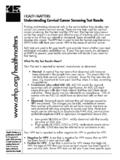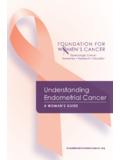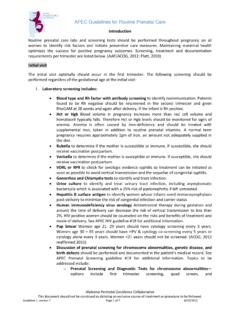Transcription of Perpetrator Risk Factors for Violence against Women
1 1 Definitions *Sexual assault covers a wide range of unwanted behaviors, such as intentional touching of the victim's genitals, anus, groin, or breasts, that are attempted or completed against a victim's will or when a victim is unable to give consent because of a disability or s/he is under the influence of alcohol or drugs. *Rape definitions vary by state, but most statutes define rape as non-consensual vaginal, anal, or oral penetration of the victim through force, threats of bodily harm, or taking advantage of a victim who is incapacitated. *Stalking is an ongoing act of Violence that includes unwanted contact ( through texts, following, online harassment, etc.)
2 With the victim. * Domestic Violence definitions vary, but often include acts of physical and/or psychological Violence committed by one partner on to another. Physical abuse can include actions as severe as a woman slammed against something by a partner or beaten by fist or object. Violence against Women Sexual assault, stalking, and domestic Violence are major public health problems within the United States. According to Centers for Disease Control and Prevention (CDC): Approximately 1 in 5 Women have been raped in their lifetimes within the , and almost 50% of American Women have experienced sexual assault other than rape during their 1 in 6 Women in the have been stalked at least once in their lifetime; 1 and Nearly 1 in 3 Women have experienced physical Violence by an intimate partner in their lives.
3 1 Various risk Factors for these acts of Violence against Women , such as alcohol use and living arrangements, have been identified for ,3,4 Perpetrators of Violence against Women Men commit the majority of violent acts against While efforts have been made to prevent men from perpetrating sexual assault, domestic Violence , and stalking, these efforts have yet to make a major impact on the rates of Violence against Women . This is because such efforts often involve overturning long-held cultural and societal beliefs. Given this reality, Violence against Women will likely continue despite best efforts to minimize Women s vulnerability to such acts unless male risk behaviors are successfully addressed.
4 Who Perpetrates Violence against Women ? Boyfriends and intimate partners are the most common perpetrators of Violence against Women . Acquaintances, such as friends and co-workers of the victim, are the second most common Perpetrator of Violence against Women . Below is a profile of who is most likely to perpetrate sexual assault, stalking, and domestic Violence . Sexual assault o More than 50% of sexual assaults, including rape, are committed by a woman s romantic , 5 o More than 40% of sexual assaults against Women are committed by an , 5 o Approximately 13% of rapes are committed by a stranger to the Perpetrator Risk Factors for Violence against Women 2 Stalking o More than two-thirds of female stalking victims are stalked by a current or former intimate o Nearly one-quarter (24%)
5 Of females who are stalked are stalked by an o Just over 13% of stalking incidents are committed by a stranger to the Domestic Violence o Almost one-third of Women experience physical Violence by an intimate partner in their ,7 o Nearly 80% of Women report they are verbally abused by a o Approximately 4 million Women suffer physical abuse by an intimate partner ,9 Age of Perpetrators While there is no definitive age for perpetrators of Violence against Women to act, age is likely to play a role when one commits such crimes. Evidence suggests younger men are more likely to commit Violence against Women , which may be explained by their increased number of dating partners and frequency in which they start new relationships.
6 Approximately one-third of all convicted rapists are under the age of 25 and almost one-fifth of all sexual assault perpetrators are 18-21 years of ,10 Male stalkers are typically in their ,11 No average age is provided for domestic Violence . However, Women aged 20-24 years of age are at greatest risk for domestic Violence by an intimate Individual Risk Factors for Violence against Women While general risk Factors exist, such as age and familiarity with the person, the vast majority of perpetrators have adopted behaviors, be it learned behaviors or societal beliefs that increase their likelihood of committing sexual assault, stalking, and domestic Violence .
7 Below is a list of traits shared among men who commit acts of Violence against Women . Previous Acts of Violence against Women : Previous acts of Violence against Women is often the biggest predictor of whether or not a man will perpetrate an act of Violence , be it sexual assault, stalking, and domestic ,13-16 For instance, men who commit rape are likely to have done so multiple times, with repeat rapists averaging rapes throughout their In regards to domestic Violence , authors of a recent study found that individuals with a history of physical Violence against their partners are 13 times more likely to commit future acts of physical aggression compared to persons who have never committed this form of physical Traditional Gender Role Beliefs: Men who hold traditional gender role beliefs (men as breadwinners, Women should stay at home, etc.)
8 14 and conform to masculinity norms (believe men need to be self-reliant, have power over Women , etc.) are more likely to commit Violence against Women , particularly sexual ,16 Alternatively, men who view Women as their equals are less likely to commit an act of sexual Personal History of or Exposure to Abuse: While the majority of individuals who experienced child abuse do not commit acts of Violence against Women , a large portion of men who commit violent acts against Women were abused as a ,19 Authors argue that child abuse, sexual or physical, may result in future perpetuation of Violence because individuals learn at a young age that such actions are acceptable and tolerable Additionally, perpetrators of domestic Violence are likely to have experienced acts of Violence against them, resulting in many experts highlighting the bi-directionality of domestic Violence .
9 3 REFERENCES 1. Black, , Basile, , Breiding, , Smith, , Walters, , Merrick, , Chen, J. & Stevens, (2011). Sexual Violence victimization. National Intimate Partner and Sexual Violence Survey: 2010 Summary Report. Centers for Disease Control and Prevention: Atlanta, GA. 2. Mohler-Kuo, M., Dowdall, , Koss, , & Wechsler, H. (2004). Correlates of rape while intoxicated in a national sample of college Women . Journal of Studies on Alcohol, 65(1), 37 45. 3. Parkhill, , Abbey, A., & Jacques-Tiura, (2009). How do sexual assault characteristics vary as a function of perpetrators' level of intoxication?
10 Addictive Behaviors, 34(3), 331-333. 4. Garrity. (2011). Sexual assault prevention programs for college-aged men: A critical evaluation. Journal of Forensic Nursing, 7(1), 40-48. 5. Franklin, (2010). Physically forced, alcohol-induced, and verbally coerced sexual victimization: Assessing risk Factors among university Women . Journal of Criminal Justice, 38(2), 149-159. 6. Miller, L. (2012). Stalking: Patterns, motives, and intervention strategies. Aggression and Violent Behaviors, 17, 495 506. 7. Fisher, , Cullen, , & Turner, (2000). National college Women sexual victimization.
